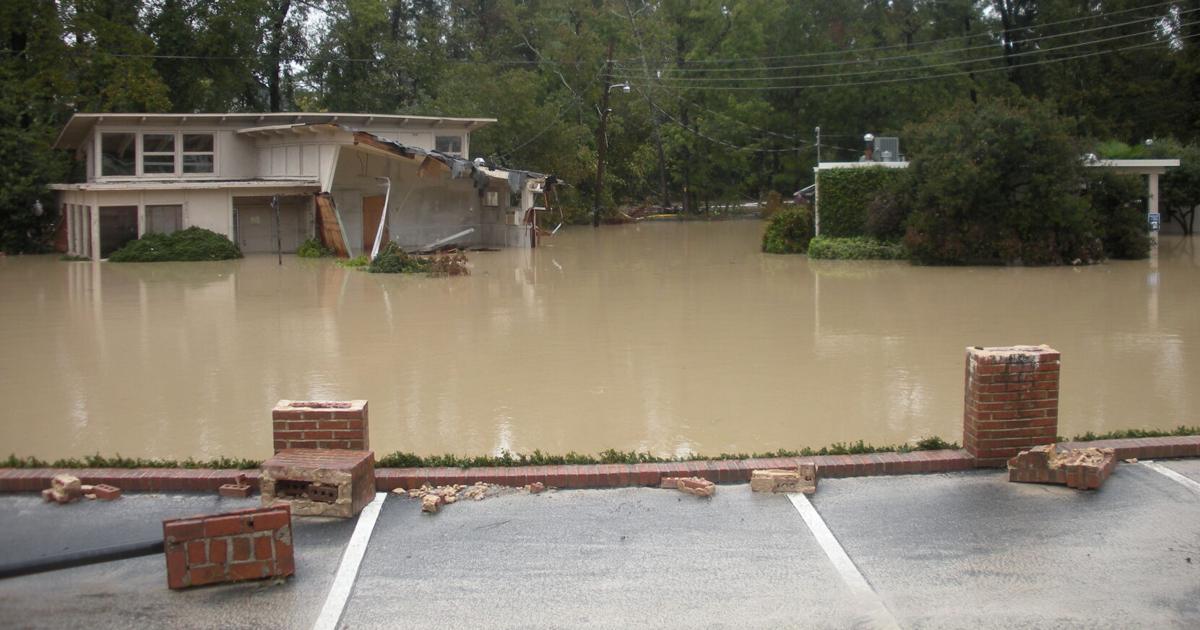
COLUMBIA — For the first five days of October 2015, Columbia and the Midlands were swamped by nearly 30 inches of rain, setting the stage for the “1,000-year flood.”
Nineteen people were killed across the state. Hundreds of homes and roadways were damaged or destroyed. Water service was spotty for days. Dams were overwhelmed and failed. Cars were swept away. Damage was estimated at just under $1.5 billion.
Like Hurricane Hugo before it and Helene after, the 2015 flood became a watershed moment for the region, becoming a cautionary tale for storms since.
Ten years later, much — but not all — of the damage has been repaired. Along with tales of destruction, memories of residents rescuing neighbors in johnboats and feeding and clothing each other in the aftermath have endured.
‘It feels like yesterday’
Brooks Brewer returned to his home off Lake Katherine from a wedding in Sumter at around midnight on Oct. 4, 2015. His wife, Brett, had grown up in the house, and in 2015 they lived there with their three daughters between ages five to two.
In all her years living there, Brett had never seen water reach higher than flooding the road, during Hugo in 1989.
At 4 a.m., Brooks and Brett awoke to the shriek of their home alarm as water rushed around their house.
They initially monitored the water’s rise, leaving their daughters asleep upstairs. Then came a call from a neighbor upstream saying a dam had just broken. More water was on the way.
“I was putting towels in front of the doors, thinking I’m gonna keep it out,” Brooks Brewer said. “And then we start hearing bubbles, and we’re like, ‘Where’s that noise coming through from?’ And it was coming up through the air vents into the house.”
At daybreak, they saw the first kayak pass their home. After bringing some of their valuables upstairs, they decided to leave when the water reached about knee-deep in their home.
They loaded 5-year-old Sarah Taylor Brewer, 4-year-old Townes and 2-year-old Anna Belle into a neighbor’s johnboat, which took them to a house on high ground down the street.
Brooks went back out in the boat and helped bring others to dry land. Some of the neighbors he assisted awoke to his knocks, stepping out of their beds into inches of water, he said.
“It feels like yesterday,” Brett Brewer said.
The weeks after the flood saw neighbors, friends and strangers help clear the mess left behind after the water receded. The Brewers stayed with family in the area until finally returning to their home five months later, they said.
“It really doesn’t feel like 10 years,” Brooks Brewer said. “Really, the girls kind of had PTSD there for a little while. Anytime we had a big storm coming, they were, like ‘Is it going to flood? Is it going to flood?’ … It was traumatic, definitely.”
‘Just floating in the middle of the flood’
Jeff Wilkinson lived in a picturesque house with a backyard overlooking Wildcat Creek, which runs from Fort Jackson to Lake Katherine.
He was used to seeing the creek swell into his yard when heavy rains came. As a reporter for The State newspaper for nearly 20 years, he was accustomed to running toward storms most people fled.
He had planned to watch the water’s progress to the house, and to leave if things got too serious. But a dam failure upstream caused the water to rise quicker than anticipated.
Wilkinson and his girlfriend, Dana, jumped into his car and backed into the street, only to be swept away by the flood waters. Water quickly reached their shoulders inside the car. The doors and windows wouldn’t budge.
The pair ultimately escaped through the sunroof and found themselves drifting down the street on the floating car. Wilkinson had somehow kept his umbrella with him, he remembered.
“For some reason, I raised the umbrella,” he said. “So in a surreal kind of scene, there we are sitting on top of my white Honda with a green golf umbrella up, just floating in the middle of the flood.”
After the car hit a group of bushes and began to sink, the pair made their way through water up to Wilkinson’s nose — he stands six feet and one inch tall — to a neighbor’s house. They huddled on the second floor of the home with the neighboring family, until a boat came by and pulled them from a second-story window.
With their cellphones ruined, Wilkinson and Dana went to a nearby hotel. The first had water — offering them a chance to shower — but no power. A second hotel had electricity, but no water. Unable to remember any phone numbers, they couldn’t reach any of their loved ones.
Wilkinson was finally able to get a message out when he made his way to the former Bluff Road offices of The State to post on his Facebook account. He spent the next year living at Dana’s apartment in Forest Acres — itself dry, but surrounded by flood damage — for over a year.
He has since moved to the top of “a big a– hill in Cayce.” He encourages everyone to keep phone numbers written down and heed flood warnings.
‘A feeling you can’t describe’
Forest Acres — considered “ground zero” for the flooding — was dealing with another tragedy before the rain began to fall.
Greg Alia, a young, recently married Forest Acres Police Department officer with a 6-month-old son, was shot and killed while on duty on Sept. 30. His death rocked the city. Those attending his funeral on Oct. 3 remember finding it fitting that a steady rain was falling.
FAPD officers and staff were given until Oct. 4 off, while other local agencies filled in, then-Police Chief Gene Sealy remembered. One employee was left at the police department headquarters when Sealy got a call that water was coming into the building.
“Poor thing was trying to sweep it out the door with a broom,” Sealy said a decade later.
Water rose along Gills Creek, cutting off Forest Drive and flooding several commercial buildings. At one point, the water completely cut the city in two. Over 170 homes and a dozen businesses were damaged.
FAPD ended up with two feet of water in its building. The water came to the top of Alia’s patrol car, which had been parked out front and covered in memorial flowers. The department coordinated operations via cellphone.
Then-Mayor Frank Brunson, after going door-to-door encouraging residents downstream to evacuate, took to the air in a state police helicopter to get an overhead view of the city’s damage.
Brunson noticed something colorful moving on the ground. He asked the pilot to take him closer. The pilot hesitated.
“When we got closer, I realized what he had been protecting me from. It was people, and all their belongings, spread out,” Brunson said. “It’s a feeling you can’t describe.”
The damage reminded him of what he saw on a visit to New Orleans in 2005 after Hurricane Katrina.
The city was swamped with issuing permits for people rebuilding homes or businesses for years after the flooding, city building official Laura Boatright said.
Some never rebuilt. Several buildings were razed and replaced with a city park honoring the flood and two FAPD officers killed in the line of duty, including Alia, in 2024. Some buildings along Gills Creek near the park remain vacant and boarded up 10 years later.
Along with the devastation, the flood is remembered for how the community rallied to support each other.
“That was one of the silver linings of it all, was that obviously we were already getting support because of what happened with Greg, and it just extended and went above and beyond when the flood happened,” Boatright said.
Private dam owners now know they are responsible for maintaining the dams to survive heavy rains, and residents are more aware of flooding and severe weather threats because of the flood, Forest Acres City Administrator Shaun Greenwood said.
Some lessons learned in disaster response in the city came in handy nine years later when Hurricane Helene caused generational wind damage in the city, Greenwood added.
“I think Helene is a very good barometer to say lessons learned from 2015 are in place now, and that’s why I think things were able to be opened and things were able to be done a lot quicker than what I think a lot of people would expect,” he said.
‘Not too much time to spare’
Clint Shealy had been on staff at the Columbia Canal Water Treatment Plant for about six weeks when the rains came. Watching the Clemson-Notre Dame football game on Oct. 3, he thought, “It just keeps raining, and it won’t stop.”
On Sunday, Oct. 4, Shealy told his wife he was going to briefly stop by the plant to check on things before meeting her at church. He was at the canal for the next six days.
That week saw the staff at the Canal Plant fighting to keep the water running for 200,000 customers, he remembered 10 years later.
First came the thousands of gallons of water “hemorrhaging” through water lines broken by rushing floodwaters, unable to be repaired or even found because they were still submerged, he said. At one point, the plant had to be evacuated due to fears over the water being released through the Lake Murray Dam’s emergency gates.
Then the canal levee broke, releasing Columbia’s primary source of drinking water into the Congaree River. Temporary pumps were able to pull water from the swollen river into the plant’s reservoir, Shealy said. But as the flood waters receded, not enough water was coming in to meet the demand of customers and broken pipes.
While some workers fought to get enough water into the system, others joined the National Guard dropping sandbags and rocks into the canal to try and head off the breach in the levee.
It wasn’t until Oct. 11 that more water was coming into the system than going out. At that point, there was less than half a day’s worth of water in the plant’s reservoir, Shealy said.
“We were all standing at the raw water reservoir kind of waiting for the bathtub swirling effect to occur. It was just nobody had ever seen it that low,” he said. “We did make it, and with not too much time to spare.”
Ten years later, the canal’s levee is still broken, though the city has recently cleared the final federal hurdles to begin repair work.
‘I’ve never seen anything like it.’
Daniel Rickenmann was watching the Clemson-Notre Dame football game on Oct. 3, 2015, with his neighbors. When the group parted ways around midnight, they were skeptical the light rain outside would measure up to the deluge that had been forecast.
“It’s just raining, you know? Maybe this isn’t coming,” Rickenmann recalled thinking.
“And then at 3:30, my next door neighbor’s knocking on my door going, ‘There’s water coming in my house,” he recalled 10 years later.
At the time on hiatus from his time as a Columbia City Councilman and some seven years before he was elected mayor, Rickenmann watched the street in front of his house turn into a river. Cars were swept away, and neighbors were stranded.
In the years since the flood, the city has invested in drainage improvements to various waterways in the city to improve flood resistance, Rickenmann said. The city has better communication with other government entities to better coordinate disaster response, and residents tend to be more flood-aware.
But to some point, little can be done about 20 inches of rain falling in five days.
“People, I mean, were caught totally off guard all the way around, and I don’t know that we could have changed anything,” he said.
‘I can remember the panic and the concern in her voice.’
State climatologist Hope Mizzell had watched the system bringing the floods roll into South Carolina before the rain had even begun to fall.
A combination of cold air in the upper atmosphere, a stationary front off the coast and the tropical moisture of Hurricane Joaquin would end up bringing 27.19 inches of rain to South Carolina from Oct. 1 to 5.
When the rain first arrived in the Midlands, Mizzell remembers receiving a call from a friend living near Lake Katherine in the Gills Creek Watershed, one of the areas hit hardest by the flooding.
“She looks out her window, and all she sees is water, and the water is up above her window of her car,” Mizzell recalled. “I can remember the panic and the concern in her voice.”
For Mizzell, the 2015 flood underscored changes that needed to be made across the state to help weather experts better prepare for and understand flooding events. While some improvements to the state’s flood modeling, more could be done.
The state is one of 10 without a statewide network of automated environmental weather stations, Mizzell said. Any automated weather stations in South Carolina are funded by counties.
‘There’s still a lot of people at risk’
John Kupfer escaped the brunt of the flooding at his home in Irmo. He stepped up to help out in Columbia, serving food to those affected by the storm. The conversations he had with the people hit hardest by the flood stand out most to him. Some wanted to talk about it, some wanted to talk about anything but.
As a scientist and geography professor at USC, Kupfer went on to study the event and its aftermath.
Actions have been taken since 2015 to prevent similar tragedies. Namely, there’s been an emphasis on converting developed, impervious, flood damaged land back into greenspace.
More greenspace means more soil to soak up more water if a similar storm were to hit Columbia again. But new development in Columbia may offset some of the effects of increased greenspace, Kupfer said.
“There’s still a lot of people at risk,” he said. “And the issue of development and how it changes the hydrology of these systems, that hasn’t really stopped.”
‘I had never seen anything like that before’
Most of the dams around Columbia that broke during the 2015 flood were repaired by 2022, but damage remains.
So much water surged down Mill Creek that it crested several feet over the park walkway that rings Pinewood Lake, said Greg Sinkler, president of the Pinewood Lake Park Foundation. Its force ripped a hole in the emergency spillway of the lake’s dam, which is owned by the foundation.
“I had never seen anything like that before,” Sinkler said, describing water slamming into the lake’s bank and crashing into the air before coming down so hard that it dug holes in the other side of the walkway.
A decade later, that breach still hasn’t been repaired, leaving the walkway unusable for the Lower Richland park’s visitors and limiting how high the lake’s water level can rise before waters flow through the open, earthen hole.
The park foundation doesn’t have any income to pay for repairs, Sinkler said, and Richland County, which owns the rest of the park, has been unwilling to fund work on the land it doesn’t own despite the foundation’s efforts.
That predicament is not limited to the Pinewood Lake dam’s owners. Most of South Carolina’s dams are privately owned, and there are limited sources of public funding to pay for the at-times costly repairs and maintenance needed on dams that could threaten lives or property if they failed. The Legislature doubled its funding for repair grants in the 2025-26 state budget to $3 million.
‘I think we made it.’
Ten years after the historic flood, much of the damage has been repaired. Some scars remain — in the boarded up windows of a lone vacant business, the still-gaping maw of the breach in the Columbia Canal or a little extra anxiety when the forecast calls for heavy rain.
Thousands of new people have come to Columbia, either to stay or through a stint at job, a university or Fort Jackson. Many of them may not remember images of cars swept off once-familiar roadways or neighbors pulling each other from second-floor windows.
But for those who lived through it, the memories of 2015 still linger, both the good and the bad.
Months after the waters had receded, Brunson — the former Forest Acres mayor — was at a community event within earshot of a city park that had stayed mostly empty since the flood, he remembered.
And for the first time since the waters rose, he could hear the sounds of children playing.
“I thought, ‘Yeah, I think we made it. I think we got through this.’”
Ian Grenier contributed to this report.



